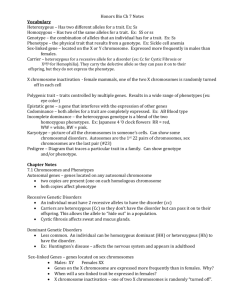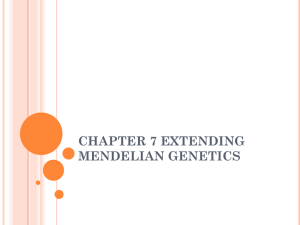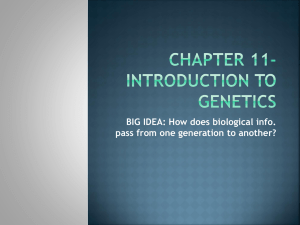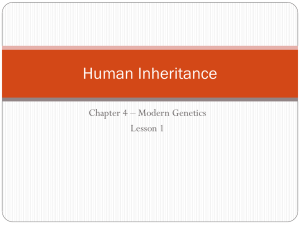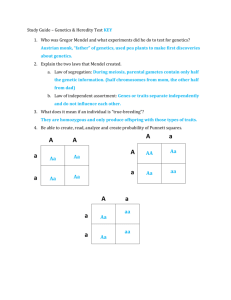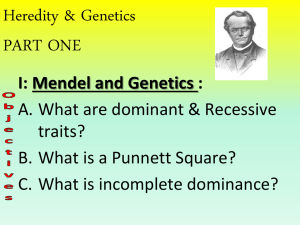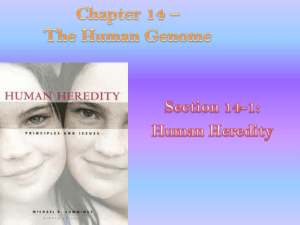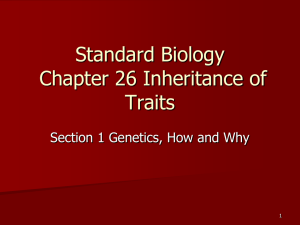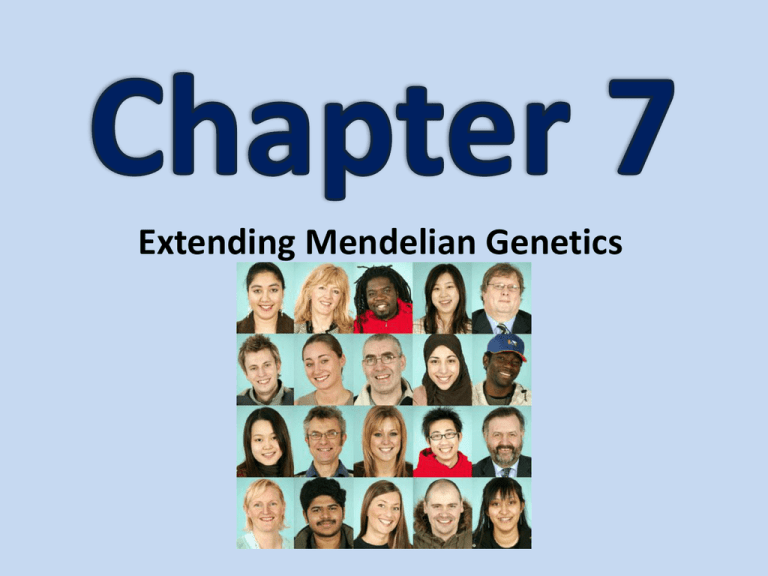
Extending Mendelian Genetics
Section 7.1: Chromosomes and Phenotype
• As you learned last chapter, some traits
depend upon dominant and recessive alleles.
• However, we have learned post-Mendel that
many other factors affect phenotype.
• The expression of a trait is often determined
by what chromosome a gene is on.
Section 7.1: Chromosomes & Phenotypes
• Remember there are
two types of
chromosomes:
– Sex chromosomes
– Autosomes
• All of Mendel’s traits
he studied were
located on autosomes.
(Most traits are!)
Section 7.1: Chromosomes & Phenotypes
• Some disorders are a result of autosomal
genes.
• Disorders are caused by either:
– 2 recessive alleles
– 1 dominant allele
• Recessive allele disorders must have two
copies of the gene.
Section 7.1: Chromosomes & Phenotypes
• Cystic Fibrosis is a
disorder that affects
lung function and is
noted by the gene
(cc).
• Cc is a carrier of this
disorder.
• Carriers do not have
the disease, but can
pass the gene on.
Section 7.1: Chromosomes & Phenotypes
• Dominant genetic disorders are much less
common.
• Huntington’s disease is a disorder that attacks
the nervous system.
• If you have one copy of the gene, you have the
disease.
• This disease doesn’t occur until later in life, so
people have already reproduced before they
know they have the disease.
Section 7.1: Chromosomes & Phenotypes
• Genes located on
the sex
chromosomes are
called sex linked
genes.
• The “Y”
chromosome
simply determines
maleness, but
there are other
types of genes on
the “X”
chromosome.
Section 7.1: Chromosomes & Phenotypes
• Sex-linked traits are expressed differently
because there is not always two copies of a gene.
• Males, only have one chromosome that carries
genes (X).
• Therefore, for some disorders, a male only needs
1 copy of a gene.
• This means males will show all recessive traits
because there is no other allele to mask.
• In females, their sex-linked traits act more like
regular traits.
Section 7.2: Complex Patterns of
Inheritance
• Although Mendel was correct in his findings,
he could not explain all the variation within a
population.
• For example, in flowers Mendel found purple
dominant to white, but there are hundreds of
colors.
• How often does this occur??
Section 7.2: Complex Patterns of
Inheritance
• Sometimes, alleles don’t
completely mask other alleles.
• In this cause, the heterozygous
condition yields a third
phenotype.
• Examples:
– cross red roses (RR) x white roses
(WW) = pink rose (RW).
– Cross a green betta fish (B1 B1) x
steel betta fish (B2B2) = royal blue
(B1B2)
Section 7.2: Complex Patterns of
Inheritance
• Incomplete Dominance can be identified by
the presence of a third phenotype that is a
mixture of the other two.
• Co-Dominance is like incomplete dominance
in that there is a third phenotype, however,
that third phenotype is both genes being
expressed:
– Red flower (RR) x white flower (WW)= flowers that
are both red and white (RW)
Section 7.2: Complex Patterns of
Inheritance
• One type of gene that we have studied
already shows Co-Dominance: Blood type
Polygenic Traits:
• Traits produced by 2 or more genes are
polygenic traits.
• For example, human skin is controlled by 4
genes that interact and produce a range of
colors.
• Eye color is the same way!
• Scientists also believe that not all genes for
eye and skin color have been found.
Polygenic Traits:
• Some genes are epistatic.
• These types of genes override any other gene
for a given trait.
• For example, albinism, is caused by one gene
that overrides all other genes that produce
pigments.
Polygenic Traits:
• Phenotype is usually a combination of
genes and environment.
– Identical twins that don’t look identical
• Scientists have mapped the human
genome.
• They have built what is called a
Karyotype
• This is a picture of all of the
chromosomes in a cell,
• Karyotypes can show abnormalities is
chromosomes shape or number.

